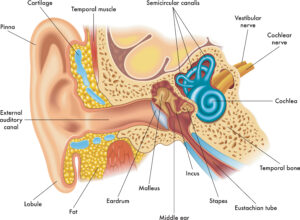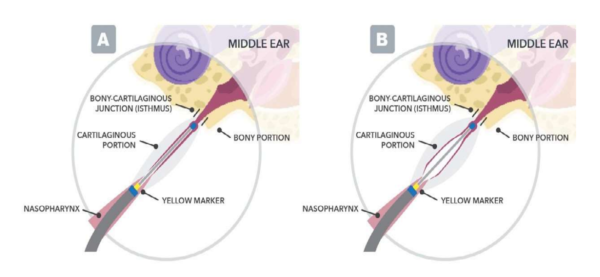
menu

Posted in Uncategorized | September 1, 2023

Do your ears feel like they are always blocked? Can you hear yourself talking too loudly?
You may have Eustachian tube dysfunction or ETD. Eustachian tube dysfunction can cause persistent pain and discomfort.
Luckily, you can find long-lasting relief with the help of a simple and effective procedure called Eustachian tube dilation. Keep reading to learn more about Eustachian ear dysfunction, how it’s linked to chronic ear infections, and what Eustachian tube dilation can do for you.

The Eustachian tubes are tiny passageways that connect your middle ear to the back of your throat. They are filled with air and usually stay closed.
But when you sneeze, yawn, chew, or swallow, the Eustachian tubes open to prevent fluid or pressure from building up. Eustachian tubes have several functions. They include:
Sometimes, the Eustachian tubes can become blocked, leading to Eustachian tube dysfunction. Eustachian tube dysfunction prevents the passageways from opening or closing correctly and performing their necessary functions.

One of the common reasons for Eustachian tube dysfunction is if the passageways become inflamed or swollen and mucus or fluid accumulates. The inflammation can be due to:
You may experience the following symptoms if you have Eustachian tube dysfunction:

The symptoms of Eustachian tube dysfunction may worsen with a change in altitude, like while flying, diving, driving through a mountain, or riding in an elevator.
Eustachian tube dysfunction is a leading cause of chronic ear infections. Fluid may collect behind your eardrum when it’s unable to drain properly due to Eustachian tube dysfunction.
If this fluid sits there for an extended time, it can lead to chronic ear infections or otitis media.
Eustachian tube dysfunction can lower your quality of life. It can be hard to focus on anything else when dealing with persistent symptoms like pain and pressure in your ears.
Without treatment, Eustachian tube dysfunction can lead to the following complications:
Antihistamines and nasal steroids are usually the first line of treatment for Eustachian tube dysfunction. But if you have a bacterial infection, your ENT specialist at Specialty Care Institute may prescribe antibiotics.
Some patients with more severe symptoms may require decongestants and oral steroids. If you have persistent Eustachian tube dysfunction that doesn’t respond to medication, your ENT specialist may recommend a procedure like Eustachian tube dilation for lasting relief.

Eustachian tube dilation is a simple yet effective procedure for treating Eustachian tube dysfunction. The FDA-approved treatment uses a tiny balloon to address the root cause of persistent Eustachian tube dysfunction.
Your ENT specialist will start by administering local anesthesia. Next, they will insert an endoscope with the Eustachian tube balloon through your nose and into the Eustachian tube.
An endoscope is a thin tube with a light and camera that aids visualization. After properly positioned, your ENT specialist will inflate the balloon to widen the blocked passageway.
The balloon is kept inflated for approximately 2 minutes, helping reshape the Eustachian tube. The balloon opens up the Eustachian tube for air and mucus to flow easily, helping to restore normal function.
Finally, your ENT specialist deflates and removes the balloon, ensuring nothing is left inside your nose. The same process is repeated on the other side if necessary.
Incisions are unnecessary, allowing the outpatient treatment to take less than 10 minutes to complete.
Some patients report relief in ear pressure immediately after treatment. Recovery from Eustachian tube dilation is often quick, with most patients able to resume their usual routine the same day.
You may experience some mild discomfort, like congestion or soreness, in the days following your Eustachian tube dilation. Your ENT specialist may prescribe a nasal spray to moisturize your nasal passages and for comfort.
Avoid blowing your nose, exercising, and other strenuous activities for at least a week. Before going home, your ENT specialist will provide detailed instructions. It’s imperative to follow these to ensure you have a smooth recovery.
You’ll continue experiencing improved symptoms up to eight weeks after the procedure.
Before, medications or ear tube surgery were the only available treatment options for Eustachian tube dysfunction. But it’s impossible to treat the persistent and painful symptoms of chronic Eustachian tube dysfunction successfully with medication without addressing the underlying cause.
Surgery to treat Eustachian tube dilation can be quite invasive as well. Otolaryngologists now recommend Eustachian tube dilation for qualified patients.
The Eustachian tube dilation system is the only available treatment in the U.S. specially designed to treat the cause of persistent Eustachian tube dysfunction.
Eustachian tube dilation uses a balloon to expand the Eustachian tubes. The treatment is highly effective, and many patients notice an improvement in their symptoms soon after their procedure.
The minimally invasive treatment offers a lasting solution for Eustachian tube dysfunction.

You may benefit from Eustachian tube dilation if you’re tired of living with chronic ear infections. Specialty Care Institute offers this revolutionary procedure to treat Eustachian tube dysfunction and chronic ear infections.
The simple and effective procedure provides long-term relief from painful symptoms and delivers lasting results. Do you think you could be suffering from Eustachian tube dysfunction?
Schedule your appointment today at Specialty Care Institute in Arlington Heights, Barrington, Elgin, or Hoffman Estates, IL, to start your journey to hearing and feeling your best.